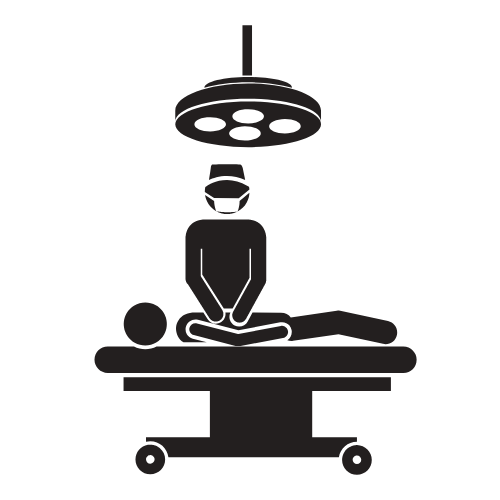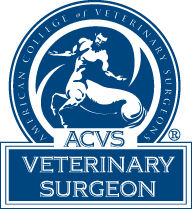THE PROBLEM:
Patella luxations are common in small dogs but can be seen in any size or breed of dog. The patella is the knee cap and just like in people, the knee cap should stay in the center of the end of the thigh bone and not be able to be displaced from this position. Luxations describe the ability for the patella to move out of the groove at the end of the thigh bone, either toward the inside(medial) or toward the outside(lateral).
Patella luxations occur due to an alignment problem of the quandriceps mechanism which encompasses the muscles on the front of the thigh inserting on the patellar and the tendon that then extends from the patella to the front of the shin bone. I like to think of this mechanism as a string, and as the muscles tighten the string is forced into a straight line. The string starts at the top of the thigh bone and inserts on the shin bone. For the patella to remain within the groove at the end of the thigh bone, the straight line formed between these two points must go through the groove. In dogs with patellar luxations, the insertion on the shin bone can develop toward the inside of the leg which moves the straight line out of alignment with the patellar groove. Alternatively, the patellar groove may develop toward the outside of the thigh bone, in which case, the line no longer transects the groove. There are many different combinations which can lead to alignment issues and patella luxation.
NORMAL LATERAL LUXATION MEDIAL LUXATION
When the patella is luxating actively during normal function, or when the patella unable to return to the normal groove, dogs will develop a functional lameness, as well as, set up a situation in which arthritis occurs. The strength of the quadriceps is markedly diminished when luxated, which causes the functional lameness. Additionally, cartilage wear and inflammation occur during the abnormal motion occurring in the knee during luxation. Finally, a medially luxating patella does pre-dispose dogs to developing a cranial cruciate ligament(ACL) tear in the future due to inflammation and over stressing of the ACL ligament.
THE SURGERY:
Because this is a structural problem, surgical intervention is commonly recommended. When surgery is recommended, the goal with surgery is to re-align and stabilized the patella in the correct position. There are many surgical techniques to perform this, however, many times the bone is cut at the insertion of the patellar tendon to allow movement of the complex back into alignment. This is commonly combined with deepening of the patella groove through techniques that allow the cartilage to be spared and bone removed underneath the cartilage. Patellar groove deepening does not help with improved alignment, but it makes it more difficult for the patella to luxate by providing a bigger barrier.
This surgery is a very intricate surgery which requires accurate re-alignment. Because we are attempting to correct an abnormality within the limb, occasionally, the patella will re-luxate ever after surgery. Though rare, recurrent luxations may require revision to improve the positioning and alignment that is achieved with the original surgery.
THE RECOVERY:
The most challenging portion of this surgery for clients is with the recovery. Recovery is broken into three phases. The first two weeks is the incision healing phase. The first 8 weeks is the bone healing phase and weeks 8-16 are the musculoskeletal rehabilitation phase.
During the incision healing phase pets should be confined in a single room within the home to prevent excessing activity. No running jumping or playing is allowed. Stairs should be limited and only performed in a controlled manner and no leash. Pets must remain on leash at all times when they are outside of their confinement. They will be required to wear an Elizabethan collar or “the terrible cone of shame” at all times during this period. Outside activity is restricted to 5 minute 2-3 times per day for bathroom break only. Your pet will be rechecked at the 2 week mark to ensure the incision has healed. If healing has occurred, then we continue into the bone healing phase.
During the bone healing phase there is no change is in home confinement, meaning a single room with no running, jumping or playing and no access to furniture is allowed. Stairs should be limited and only performed in a controlled manner and no leash. Pets must remain on leash at all times when they are outside of their confinement. For weeks 2-4 pets are allowed 10 minute leash walks 2-3 times per day. For week 4-6 pets are allowed 15minute leash walks 2-3 times per day and for weeks 6-8 pets are allowed 20 minute leash walks 2-3 times per day. Your pet will be rechecked at the 8 week mark and X-rays will be performed to ensure proper healing. Assuming proper healing has been achieved, your pet can transition to the rehabilitation phase.
During the rehabilitation phase, no restrictions are required within the home, however, we have taken a professional athlete, which all pets are, as they perform things people could never do, and made them a couch potato for 8 weeks. Now all there muscles, ligaments and tendons are out of condition and need to be slowly reconditioned to their normal status. This is performed with 2-4 weeks of unlimited on leash activity followed by 2-4 weeks of controlled off leash activity prior to return to normal function.



